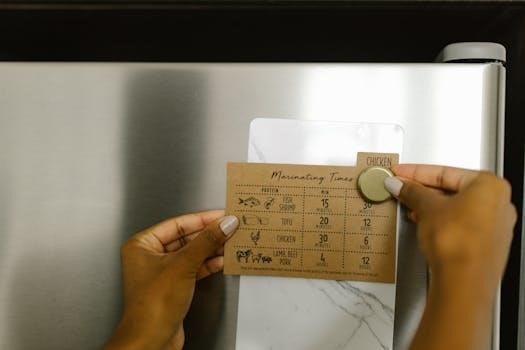
-
By:
- elizabeth
- No comment
sports card thickness guide
Understanding sports card thickness is crucial for collectors. Card thickness, measured in points (pt), impacts storage and protection. One point equals 0.001 inches or 0.0254 millimeters. This guide helps you navigate varying thicknesses and choose appropriate holders for your valuable cards, ensuring their preservation.

Why Card Thickness Matters
Card thickness is paramount for several reasons when it comes to sports card collecting. Primarily, it dictates the type of protective storage required. Standard base set cards, typically around 20pt, fit easily into regular toploaders and magnetic holders. However, insert cards, memorabilia cards, and autographed cards often boast increased thickness, ranging from 40pt to over 100pt.
Using an incorrectly sized holder can damage the card. A holder too small can bend or warp the card, while one too large leaves the card vulnerable to movement and potential surface damage. Furthermore, knowing the card’s thickness helps determine its authenticity. Counterfeiters often use incorrect card stock, resulting in noticeable thickness discrepancies.
Properly assessing card thickness also ensures optimal display. Choosing the right holder allows the card to be presented securely and attractively, enhancing its visual appeal. Ultimately, understanding card thickness protects your investment and preserves the integrity of your collection for years to come.
Measuring Card Thickness⁚ Points, Inches, and Millimeters
Accurately measuring card thickness is essential for proper storage and protection. The standard unit of measurement in the sports card world is “points” (pt). One point is equivalent to 0.001 inches, or 0.0254 millimeters. Understanding these units allows collectors to select appropriately sized toploaders and magnetic holders.
For instance, a card with a thickness of 20pt is 0.02 inches or 0.508 millimeters thick. Memorabilia cards, significantly thicker, can range from 100pt (0.1 inches or 2.54 millimeters) upwards. Knowing these conversions is crucial when using tools like card thickness point gauges or digital calipers;
Card thickness point gauges are designed with slots corresponding to various point values, allowing for quick and easy assessment. Digital calipers provide precise measurements in inches or millimeters, which can then be converted to points. By mastering these measurements, collectors can confidently safeguard their prized possessions from damage and ensure they are displayed optimally.
Tools for Measuring Card Thickness
Accurately measuring card thickness requires specific tools. Card thickness point gauges and digital calipers are essential. These tools ensure proper storage by determining the card’s point value, crucial for selecting appropriate toploaders or magnetic holders.
Card Thickness Point Gauges
Card thickness point gauges are essential tools designed for measuring the thickness of sports and trading cards. These gauges typically feature a series of slots or openings, each corresponding to a specific card thickness measured in points (pt). One point equals 0.001 inches or 0.0254 millimeters.
To use a card thickness point gauge, simply slide the card into the slots until you find the one that provides a snug fit without forcing the card. The number associated with that slot indicates the card’s approximate thickness. These gauges are often made from clear plastic, allowing for easy viewing and measurement from any angle.
BCW Supplies offers downloadable card-sized gauges, which can be printed for convenient use. These gauges display various thicknesses corresponding to their sports card holders. Using a point gauge helps determine the correct toploader or magnetic holder size, ensuring optimal protection for your valuable collectibles. They are a simple, effective way to avoid damaging cards due to improper storage.
Digital Calipers
Digital calipers offer a precise method for measuring card thickness compared to point gauges. These instruments provide digital readouts in inches or millimeters, convertible to points (where 1 point equals 0.001 inches or 0.0254 millimeters). To use digital calipers, gently close the jaws onto the card’s edge, ensuring not to apply excessive pressure that could damage the card.
The digital display shows the exact thickness, allowing for accurate selection of appropriate toploaders or magnetic holders. Digital calipers are especially useful for measuring memorabilia cards or those with unusual thicknesses, where precision is crucial. Some calipers can measure to an accuracy of 0.0001 inches, offering highly reliable readings.
While they might be a slightly more expensive option than point gauges, digital calipers provide greater accuracy and versatility. They can measure various items beyond cards, making them a valuable tool for collectors seeking precise measurements for optimal card protection and storage solutions.

Standard Card Thickness
Most standard base set cards have a thickness of 20pt, equating to 0.02 inches or 0.5 millimeters. Knowing this standard helps collectors gauge the thickness of other cards and choose suitable protective holders accordingly for safe keeping.
Base Set Cards (20pt)
Base set cards typically measure around 20pt, representing the standard thickness in the sports card world. This measurement, equivalent to 0.02 inches or 0.5 millimeters, forms a baseline for understanding card dimensions.
Most regular sports cards you encounter will fall into this category. This standard thickness ensures uniformity within a base set, facilitating easier storage and handling. Due to their commonality, 20pt cards are the most straightforward to protect.
Selecting toploaders and magnetic holders for 20pt cards is simple, as most standard-sized products cater to this thickness. Collectors can easily find suitable protective measures without needing specialized equipment or accessories. Recognizing this standard is essential for efficient and effective card preservation within a collection, particularly for sets meant for everyday trade or viewing.
Understanding the 20pt standard is the foundation for grasping card thickness variations within the hobby, and comparing them to other cards.

Variations in Card Thickness
Sports cards vary in thickness beyond the standard 20pt. Insert cards, memorabilia cards, and autograph cards often boast increased thickness. Knowing these variations ensures proper protection using suitable toploaders and magnetic holders designed for specific dimensions.
Insert Cards (40-50pt)
Insert cards represent a notable step up in thickness compared to standard base set cards. Typically ranging from 40pt to 50pt, these cards often feature premium designs, special finishes, or limited-edition status. Their increased thickness provides a more substantial feel and visual appeal, contributing to their collectibility. This variation in thickness necessitates the use of appropriately sized toploaders or magnetic holders to ensure a snug and secure fit. Using holders designed for thinner cards can damage insert cards, while excessively large holders may not provide adequate protection.
Collectors must pay attention to the specific point measurement when selecting protective supplies. Checking manufacturer specifications or utilizing a card thickness gauge guarantees the right fit. Properly housing insert cards preserves their condition and enhances their long-term value. Remember, accurate measurement and appropriate storage are key to safeguarding these prized additions to any sports card collection.
Memorabilia Cards (100pt+)
Memorabilia cards represent the thickest category, often exceeding 100pt due to embedded relics like jersey pieces or autographs. These cards demand specialized storage solutions for adequate protection. Standard toploaders are insufficient; instead, opt for thicker toploaders or magnetic holders designed specifically for memorabilia cards. Accurately measuring card thickness is crucial; a card thickness gauge is essential.
Forcing a thick memorabilia card into an undersized holder risks damage, bending, or even breaking the embedded relic. Conversely, using an excessively large holder leaves the card vulnerable to movement and potential damage. Magnetic one-touch holders are a popular choice, providing a secure and aesthetically pleasing display. Ensure the holder’s point measurement matches the card’s thickness. Proper storage preserves the card’s condition, value, and the integrity of the embedded memorabilia, protecting your investment.
Toploaders and Magnetic Holders Based on Thickness
Selecting the correct toploader or magnetic holder is paramount for preserving card condition; Standard base set cards (20pt) fit snugly in regular toploaders; Thicker insert cards (40-50pt) require correspondingly larger toploaders to prevent bending. Memorabilia cards (100pt+) necessitate specialized, extra-thick toploaders or magnetic holders.
Magnetic holders offer superior protection and display. They come in various thicknesses, measured in points. Match the holder’s point value to the card’s thickness for a secure fit. A card thickness gauge ensures accurate measurement. Using an undersized holder can damage the card, while an oversized holder allows movement, risking scratches. Common sizes include 35pt, 55pt, 75pt, 100pt, 130pt, 180pt, and 360pt. Always prioritize a snug, secure fit for optimal protection and long-term preservation, safeguarding your valuable collection from damage and maintaining its value.
Printable Card Thickness Guides
Printable card thickness guides are invaluable tools for collectors. These guides, often available as downloadable PDFs, provide a visual reference for determining card thickness. They typically feature a series of labeled slots or gauges, each corresponding to a specific point value (e.g., 20pt, 35pt, 55pt, 100pt).
To use a printable guide, simply print it at 100% scale to ensure accurate sizing. Then, carefully slide your card into the slots until you find the one that provides a snug fit. The labeled point value of that slot indicates the card’s approximate thickness.
These guides are especially useful for quickly assessing the thickness of multiple cards. They help in selecting the correct toploaders or magnetic holders for optimal protection. BCW Supplies and Ultra PRO offer such printable guides. Keep one handy in your collection area for easy reference. Remember to periodically check the print scale for accuracy.

Card Thickness of Different Brands
Card thickness can vary slightly between different brands. While most standard base cards aim for a thickness around 20pt, subtle differences can exist. For example, Topps trading cards often measure between 20-30 points, whereas Upper Deck cards might be slightly thicker, ranging from 24-35 points.
These variations can be attributed to the type of card stock used or specific manufacturing processes employed by each company. Premium or insert cards from any brand typically deviate even further from the standard, often being significantly thicker. Memorabilia cards, with embedded relics, exhibit the most considerable thickness variations, frequently exceeding 100pt.
Consequently, collectors should not assume all cards have the same thickness. It’s best practice to measure cards individually, especially when dealing with valuable or unique items. Utilizing a card thickness gauge will ensure accurate assessment and appropriate storage selection, regardless of the brand.
Navigating the world of sports card collecting requires attention to detail, and understanding card thickness is a key aspect. From standard base cards to thick memorabilia pieces, knowing the thickness allows you to properly store and protect your collection. Using tools like point gauges or digital calipers helps ensure accurate measurements.
Remember, standard cards are typically around 20pt, while inserts and memorabilia can range from 40pt to over 100pt. Choosing the right toploader or magnetic holder is crucial for preserving the condition of your cards. Variations exist between brands and card types, making consistent measurement essential.
By utilizing the knowledge and tools outlined in this guide, collectors can confidently manage their collections, ensuring the long-term value and integrity of their prized sports cards, and avoid damage. Prioritize protection; measure accurately!